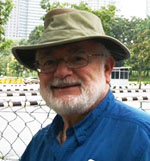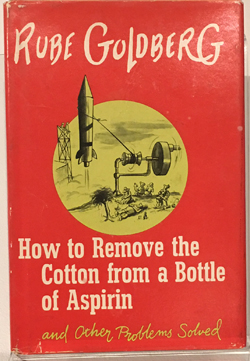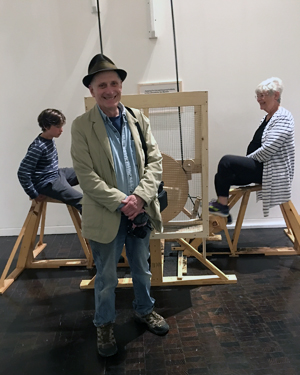By Oliver Pollak

 SAN FRANCISCO — The Contemporary Jewish Museum just celebrated its 10th anniversary. The celebration coincided with an exhibit on cartoonist and inventor Rube Goldberg, curated by Goldberg’s granddaughter, Jennifer George. Initially that exhibit had opened in Seattle, then came to San Francisco from Canadian, Texas, and goes next to Portland, Maine. It will end in Queens, New York.
SAN FRANCISCO — The Contemporary Jewish Museum just celebrated its 10th anniversary. The celebration coincided with an exhibit on cartoonist and inventor Rube Goldberg, curated by Goldberg’s granddaughter, Jennifer George. Initially that exhibit had opened in Seattle, then came to San Francisco from Canadian, Texas, and goes next to Portland, Maine. It will end in Queens, New York.
Goldberg once stated he could do two cartoons a day, but it takes a week to make one of his machines. The closest I came to Rube Goldberg gimcrack was to imagine a hand-powered generator attached to a portable radio on top of Mount Whitney. I rethought this cockamamie plan, not wishing to carry it from 8,000 to 14,505 feet.
Goldberg addresses common human, political, and technological problems with unconventional hilarity. Last I checked, there were nine copies of Goldberg’s How to Remove the Cotton from a Bottle of Aspirin (1959) on abebooks ranging from $20 to $707 with no explanation for the spread. I would extend this conundrum to bottles with vitamin pills. According to my wife anything that has a powdery coating and is not a capsule gets cotton to protect it during shipping, and she is correct. However, some biopharma still use cotton unnecessarily and detrimentally for smooth coated pills.
It seems like a waste to just throw the cotton away as if it were dirty; it looks so snowy clean. Can I use it to apply calamine lotion, mercurochrome or iodine or to take off makeup? Does the cotton wool go in recyclable trash with paper and bottles or with compostable garbage like a banana peel? In 1959, it was simple garbage. Perhaps I should spend $20, or go to the library, and read the book.
According to Rich Tenorio in The Times of Israel (20 April 2018) Goldberg in 1922 declined to change his name, as did the future Supreme Court justice Felix Frankfurter. Goldberg became wealthy as a syndicated cartoonist who also worked in the film industry. In the 1930s he received anti-Semitic hate mail. His sons changed their name. One son, George W. George, wrote My Dinner with Andre.

Born in San Francisco in 1883, Goldberg graduated from UC Berkeley, then simply known as “Cal,” in 1904. By 1926 “Rube Goldberg” was in the dictionary defined as “accomplishing by overly complex and humorous means what seemingly could be done simply.” He died in 1970 at the age of 87, perhaps the Leonardo da Vinci of pop science and humor.
The second floor of the museum is hosting “Contraptions: Rediscovering California Jewish Artists,” a CJM curation, in which 16 artists imagine fantastical interfaces between art and mechanics. Bernie Lubell, inspired as a child by Rube Goldberg, creates interactive wood machines. He linked bicycle pedal power soaring 25 feet to the ceiling to weave rope. His “A Theory of Entanglement,” a steroidal construction, was exhibited in Liverpool and Rotterdam in 2009. He received a Guggenheim Fellowship in 2011. He is working on getting it to China, trade wars notwithstanding. Philosophically he likens it to life’s unpredictable twists and turns.
The CJM is a wonderful museum. I am sorry they closed their first class gift shop in January. Alas even museum gift shops are at risk competing with online retailers. My 12-year-old grandson enjoyed the exhibit, especially the Goldberg comic books “with funny little pictures.” I suggested we do a museum a month, probably sustainable in the Bay Area for a while. The CJM is open on Shabbat. It’s not a religious museum, its open to everyone. It is closed on Wednesday.
*
Pollak, a professor emeritus of history at the University of Nebraska Omaha, and a lawyer, is a freelance writer now based in Richmond, California. He may be contacted via oliver.pollak@sdjewishworld.com